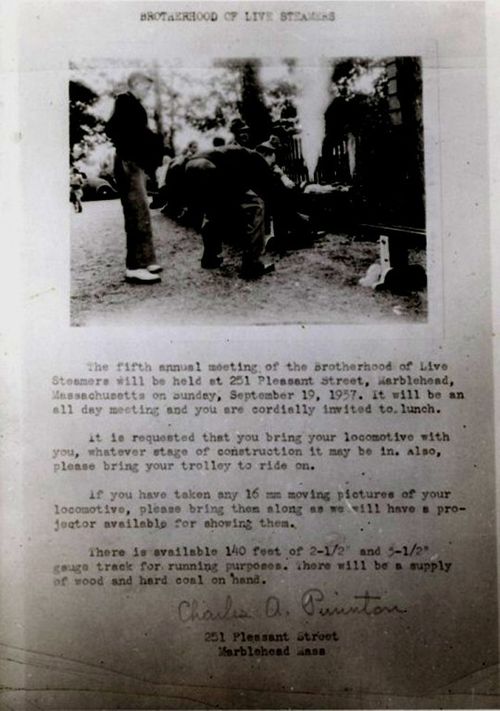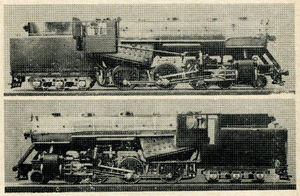IBLS Journal 1937
Jump to navigation
Jump to search

See Window Advertising: Southern Pacific General Offices
BLS 5th Annual Meeting
The Miniature Locomotive, May-June 1953
These photos of Harry Sait's 3-1/2 inch gauge Boston and Albany Tank were taken at the 5th annual meeting of the Brotherhood of Live Steamers at Marblehead in September 1937. Few people know that this is the original miniature from which a number of others were made to follow. It is a typical "Sait" engine that has always been a pleasure to run. She steams freely, uses little coal and water and hooks up to one notch off center in either direction.

A photocopy of the invitation to the 5th Annual BLS Meet held in 1937 at the Purinton residence a Marblehead, MASS. This copy was in a collection of photos of Rex Smith of Port Rowan, Ontario, posted on Chaski.org by Steve Bratina
Visited by Carl
B&O Bob of Blue Bell, PA, posted on Chaski.org, 8 June 2018:
- In 1937, when I was ten years old, we had a ground level(!) 32-foot loop of 2.5 inch gauge track in our backyard in Brookline, PA where I learned how to balance myself on a 2.5 inch gauge riding car behind my father's B&O P-7. I remember one afternoon when "Mr. Purinton" visited us (afterall I was only ten and that's the way we addressed our elders in that era). We had lunch and then ran the P-7 hauling a 13-car train of freight cars and two cabooses, all the while Pop and Mr. Purinton chatting about live steam, their shops, LBSC, and the future. Charles certainly did more than anyone else to advance growth of the live steam hobby in North America with those visits and his roving book!
- My father traveled with friends to Marblehead one year shortly after that, returning with great stories of the men they met there. Later, a second trip, during the war and after saving enough gas ration stamps, they went to a meet at Danvers, bringing back the most marvelous coal I ever burned, known as Russian Anthracite. The coal arrived in the U.S. as ballast on freighters returning otherwise empty from Russia after delivering a load of Lend/Lease military material to assist the Russian war effort. Locals burned the coal in their heating furnaces and claimed they got only "a bushel of cinders per ton of coal. Well they were right, because as the coal burned, small particles of fly ash went up the chimney, and similarly, when it was burned in a live steam locomotive, you had only to lightly rake the fire and then shovel-on more coal. At the end of the day there was almost no ash in the firebox, and no clinkers, although the smokebox usually had an accumulation of ashes and particles of unburned coal that had flaked-off burning coal but were too big to be exhausted. Visiting live steamers brought back all the Russian Anthracite they could carry, and in fact, I still had a few pounds squirreled away when I had to quit running, and that was passed along to a friend for his coal-fired Gauge-1 engine.
Saturday Evening Post
The Brotherhood of Live Steamers is mentioned in an article "The Iron Hobby Horse" in the Saturday Evening Post.
